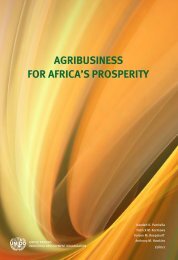Collection of Case Studies 2. - Seas of Change Initiative
Collection of Case Studies 2. - Seas of Change Initiative
Collection of Case Studies 2. - Seas of Change Initiative
Create successful ePaper yourself
Turn your PDF publications into a flip-book with our unique Google optimized e-Paper software.
9. Pastoralist livestock markets in Kenya: Establishing thriving andreliable livestock markets through an innovative public-privatearrangementAuthor: Obiero Thomas WereOrganisation: SNV – Netherlands Development OrganisationThis case is one <strong>of</strong> a series specifically prepared by SNV and local partners for the “<strong>Seas</strong> <strong>of</strong> <strong>Change</strong>” event,taking place in The Hague, 11-13 April 201<strong>2.</strong> The cases cover a range <strong>of</strong> commodities and approaches in valuechain development across Africa, Asia and Latin America. They usually include several <strong>of</strong> the following elements:strengthening <strong>of</strong> producer organisations, productivity improvement and value addition, business developmentservices, inclusive business ventures, contract farming, marketing arrangements and improved chain financing.The work has been done with local entrepreneurs, NGOs and government bodies. Among the internationalcollaborative partners are: IFAD, FAO, EU, USAID, DANIDA, Helvetas and IDB. The business partner involved in thecase is Livestock Marketing Association.Key featuresLocal Kenyan county councils, with aid from SNV, have been able to facilitate the co-management <strong>of</strong> livestockmarkets together with livestock farming communities. Livestock Management Associations from thesecommunities have been empowered to effectively manage the market places and operate a number <strong>of</strong> functionsthat were previously done by government staff. This has resulted in the development <strong>of</strong> increasingly vibrantmarkets for livestock and livestock products as well as other transactions. The model has rapidly spread to over20 markets in seven counties, benefiting more than 80,000 households with increases in livestock prices <strong>of</strong> 20to 30%. The markets are similarly attractive to buyers who find assured supply, increase efficiencies in transportand other benefits. Diverse enterprises have also sprouted up at these markets providing alternative livelihoodsfor especially women and young people all year round; hence enhancing their resilience to cyclical droughts. Themarkets have also gained importance as an interface with farming communities for government programmes andthe activities <strong>of</strong> international development agencies.1. Context and backgroundLivestock farmers have continuously relied on herds <strong>of</strong> goats and camels as their single most important source<strong>of</strong> livelihood. Besides providing food directly in the form <strong>of</strong> meat and milk, they were able to trade livestock tomeet urgent cash needs such as school fees and staple foods. The government <strong>of</strong> Kenya supported livestockmarketing from these regions through the livestock marketing division that enabled livestock farmingcommunities to achieve competitive prices.However, the government discontinued its direct role in livestock marketing during the introduction <strong>of</strong> theStructural Adjustment Programmes that aimed to implement "free market" programmes and policies in the1990s. This led to the degradation <strong>of</strong> the once well-established market. The consequences since then have beensignificant inefficiencies including ineffective market places, high transaction costs, unstable prices, andinsecurity.These high transaction costs emanate from, among other factors, the ‘lengthy channels’ created by longdistances to markets. The long distances involved in trekking animals to the market led to increased livestockmortality, reduced animal/carcass value and exorbitant charges en-route, high transport costs, and loss throughtheft <strong>of</strong> stock. The only opportunity to avoid these long distances is by selling livestock to middle men for lowprices. Other issues that hamper the effective participation <strong>of</strong> producers in distant markets include their limitededucation and poor knowledge <strong>of</strong> the national language. This is particularly true for poorer livestock farmers,such as smaller herders, women and young people, who are forced to rely on several middle men, resulting inreduced pr<strong>of</strong>it margins.In 2007 and 2008, SNV, in partnership with the Samburu Integrated Development Programme (SIDEP), KenyaLivestock Marketing Council (KLMC) and Samburu County Council (SCC) explored the potential <strong>of</strong> interior (primary)markets as a business model to address these challenges.42







